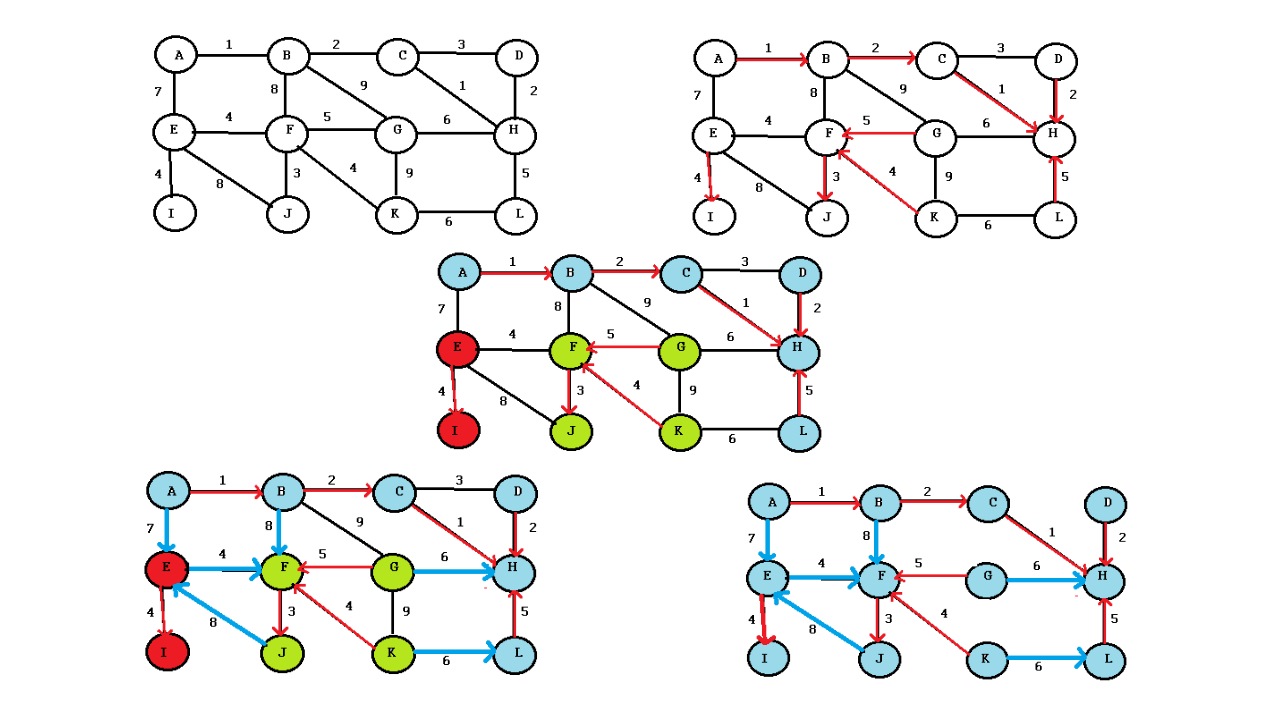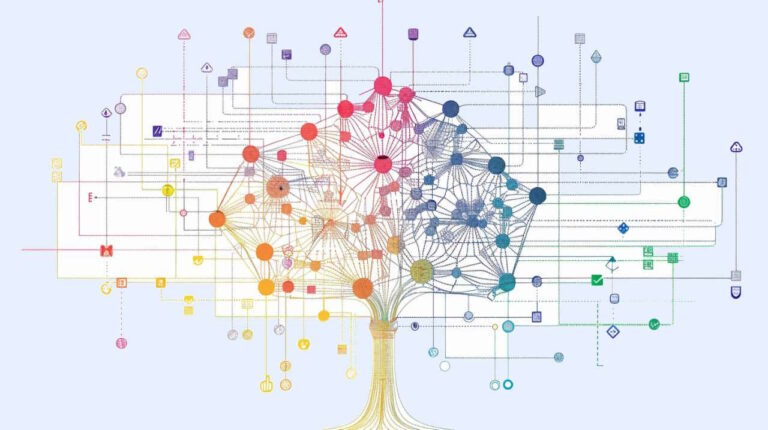الگوریتم بروکا (Boruvka’s Algorithm) — راهنمای کاربردی

در این مطلب، «الگوریتم بروکا» (Boruvka’s Algorithm) مورد بررسی قرار گرفته و پیادهسازی آن در زبانهای برنامهنویسی C++/C و پایتون انجام شده است. الگوریتم بروکا نیز مانند «الگوریتم پریم» (Prim's Algorithm) و «الگوریتم کراسکال» (Kruskal Algorithm)، یک «الگوریتم حریصانه» (Greedy Algorithm) است.
الگوریتم بروکا
در زیر، الگوریتم بروکا به طور کامل ارائه شده است.
- ورودی، یک گراف متصل، وزندار و غیر جهتدار است.
- همه راسها را به عنوان عنصرهای مجزا مقداردهی کن.
- درخت پوشای کمینه را به عنوان empty مقداردهی اولیه کن.
- در حالیکه بیش از یک عنصر وجود دارد، برای هر عنصر، اقدامات زیر را انجام بده:
- یالی با نزدیکترین وزن که این عنصر را به سایر عناصر متصل میکند، پیدا کن.
- این نزدیک یال را در صورتی که تاکنون به درخت پوشای کمینه اضافه نشده، اضافه کن.
- درخت پوشای کمینه را بازگردان.
در ادامه، ایده نهفته در پس الگوریتم بروکا، همراه با مثال نمایش داده شده است. شایان ذکر است که ایده این الگوریتم، مانند الگوریتم «درخت پوشای کمینه» (Minimum Spanning Tree) پریم است. منظور از درخت پوشای کمینه آن است که همه راسها متصل باشند. بنابراین، دور زیرمجموعه غیرمتصل (که در بالا تشریح شده است) از راسها باید متصل باشند تا یک درخت پوشا ساخته شود. همچنین، آنها باید با یال دارای حداقل وزن متصل شوند تا از آن یک درخت پوشای کمینه بسازند. در ادامه، مفهوم این الگوریتم با استفاده از مثالی، بیان میشود.

به طور اولیه، MST خالی است. هر راسی یک عنصر مجرد است که با خط آبی در تصویر زیر مشخص شده است.

برای هر عنصر، کموزنترین یالی که آن را به دیگر عنصرها متصل میکند، یافت میشود.
Component Cheapest Edge that connects
it to some other component
{0} 0-1
{1} 0-1
{2} 2-8
{3} 2-3
{4} 3-4
{5} 5-6
{6} 6-7
{7} 6-7
{8} 2-8
سبکترین یالها با رنگ سبز مشخص شدهاند. اکنون، درخت پوشای کمینه به صورت $${0-1, 2-8, 2-3, 3-4, 5-6, 6-7}$$ است.

پس از مراحل بالا، عنصرها $${{0,1}, {2,3,4,8}, {5,6,7}}$$ هستند. این عنصرها با دوایر آبی رنگ مشخص شدهاند.

اکنون، مجددا مراحل تکرار میشوند. برای هر عنصر، سبکترین یالی که آن را به دیگر عنصرها متصل میکند، پیدا میشود.
Component Cheapest Edge that connects
it to some other component
{0,1} 1-2 (or 0-7)
{2,3,4,8} 2-5
{5,6,7} 2-5
سبکترین یالها با رنگ سبز مشخص شدهاند. اکنون، درخت پوشای کمینه به صورت $${0-1, 2-8, 2-3, 3-4, 5-6, 6-7, 1-2, 2-5}$$ است.

در این گام، تنها یک عنصر {0, 1, 2, 3, 4, 5, 6, 7, 8} وجود دارد که همه یالها را دربر میگیرد. با توجه به اینکه تنها یک عنصر باقی مانده است، کار متوقف و درخت پوشای کمینه بازگردانده میشود. در ادامه، پیادهسازی الگوریتم بروکا در زبانهای برنامهنویسی C++/C و پایتون انجام شده است.
پیادهسازی الگوریتم بروکا در C++/C
1// Boruvka's algorithm to find Minimum Spanning
2// Tree of a given connected, undirected and
3// weighted graph
4#include <stdio.h>
5
6// a structure to represent a weighted edge in graph
7struct Edge
8{
9 int src, dest, weight;
10};
11
12// a structure to represent a connected, undirected
13// and weighted graph as a collection of edges.
14struct Graph
15{
16 // V-> Number of vertices, E-> Number of edges
17 int V, E;
18
19 // graph is represented as an array of edges.
20 // Since the graph is undirected, the edge
21 // from src to dest is also edge from dest
22 // to src. Both are counted as 1 edge here.
23 Edge* edge;
24};
25
26// A structure to represent a subset for union-find
27struct subset
28{
29 int parent;
30 int rank;
31};
32
33// Function prototypes for union-find (These functions are defined
34// after boruvkaMST() )
35int find(struct subset subsets[], int i);
36void Union(struct subset subsets[], int x, int y);
37
38// The main function for MST using Boruvka's algorithm
39void boruvkaMST(struct Graph* graph)
40{
41 // Get data of given graph
42 int V = graph->V, E = graph->E;
43 Edge *edge = graph->edge;
44
45 // Allocate memory for creating V subsets.
46 struct subset *subsets = new subset[V];
47
48 // An array to store index of the cheapest edge of
49 // subset. The stored index for indexing array 'edge[]'
50 int *cheapest = new int[V];
51
52 // Create V subsets with single elements
53 for (int v = 0; v < V; ++v)
54 {
55 subsets[v].parent = v;
56 subsets[v].rank = 0;
57 cheapest[v] = -1;
58 }
59
60 // Initially there are V different trees.
61 // Finally there will be one tree that will be MST
62 int numTrees = V;
63 int MSTweight = 0;
64
65 // Keep combining components (or sets) until all
66 // compnentes are not combined into single MST.
67 while (numTrees > 1)
68 {
69 // Everytime initialize cheapest array
70 for (int v = 0; v < V; ++v)
71 {
72 cheapest[v] = -1;
73 }
74
75 // Traverse through all edges and update
76 // cheapest of every component
77 for (int i=0; i<E; i++)
78 {
79 // Find components (or sets) of two corners
80 // of current edge
81 int set1 = find(subsets, edge[i].src);
82 int set2 = find(subsets, edge[i].dest);
83
84 // If two corners of current edge belong to
85 // same set, ignore current edge
86 if (set1 == set2)
87 continue;
88
89 // Else check if current edge is closer to previous
90 // cheapest edges of set1 and set2
91 else
92 {
93 if (cheapest[set1] == -1 ||
94 edge[cheapest[set1]].weight > edge[i].weight)
95 cheapest[set1] = i;
96
97 if (cheapest[set2] == -1 ||
98 edge[cheapest[set2]].weight > edge[i].weight)
99 cheapest[set2] = i;
100 }
101 }
102
103 // Consider the above picked cheapest edges and add them
104 // to MST
105 for (int i=0; i<V; i++)
106 {
107 // Check if cheapest for current set exists
108 if (cheapest[i] != -1)
109 {
110 int set1 = find(subsets, edge[cheapest[i]].src);
111 int set2 = find(subsets, edge[cheapest[i]].dest);
112
113 if (set1 == set2)
114 continue;
115 MSTweight += edge[cheapest[i]].weight;
116 printf("Edge %d-%d included in MST\n",
117 edge[cheapest[i]].src, edge[cheapest[i]].dest);
118
119 // Do a union of set1 and set2 and decrease number
120 // of trees
121 Union(subsets, set1, set2);
122 numTrees--;
123 }
124 }
125 }
126
127 printf("Weight of MST is %d\n", MSTweight);
128 return;
129}
130
131// Creates a graph with V vertices and E edges
132struct Graph* createGraph(int V, int E)
133{
134 Graph* graph = new Graph;
135 graph->V = V;
136 graph->E = E;
137 graph->edge = new Edge[E];
138 return graph;
139}
140
141// A utility function to find set of an element i
142// (uses path compression technique)
143int find(struct subset subsets[], int i)
144{
145 // find root and make root as parent of i
146 // (path compression)
147 if (subsets[i].parent != i)
148 subsets[i].parent =
149 find(subsets, subsets[i].parent);
150
151 return subsets[i].parent;
152}
153
154// A function that does union of two sets of x and y
155// (uses union by rank)
156void Union(struct subset subsets[], int x, int y)
157{
158 int xroot = find(subsets, x);
159 int yroot = find(subsets, y);
160
161 // Attach smaller rank tree under root of high
162 // rank tree (Union by Rank)
163 if (subsets[xroot].rank < subsets[yroot].rank)
164 subsets[xroot].parent = yroot;
165 else if (subsets[xroot].rank > subsets[yroot].rank)
166 subsets[yroot].parent = xroot;
167
168 // If ranks are same, then make one as root and
169 // increment its rank by one
170 else
171 {
172 subsets[yroot].parent = xroot;
173 subsets[xroot].rank++;
174 }
175}
176
177// Driver program to test above functions
178int main()
179{
180 /* Let us create following weighted graph
181 10
182 0--------1
183 | \ |
184 6| 5\ |15
185 | \ |
186 2--------3
187 4 */
188 int V = 4; // Number of vertices in graph
189 int E = 5; // Number of edges in graph
190 struct Graph* graph = createGraph(V, E);
191
192
193 // add edge 0-1
194 graph->edge[0].src = 0;
195 graph->edge[0].dest = 1;
196 graph->edge[0].weight = 10;
197
198 // add edge 0-2
199 graph->edge[1].src = 0;
200 graph->edge[1].dest = 2;
201 graph->edge[1].weight = 6;
202
203 // add edge 0-3
204 graph->edge[2].src = 0;
205 graph->edge[2].dest = 3;
206 graph->edge[2].weight = 5;
207
208 // add edge 1-3
209 graph->edge[3].src = 1;
210 graph->edge[3].dest = 3;
211 graph->edge[3].weight = 15;
212
213 // add edge 2-3
214 graph->edge[4].src = 2;
215 graph->edge[4].dest = 3;
216 graph->edge[4].weight = 4;
217
218 boruvkaMST(graph);
219
220 return 0;
221}
222
223// Thanks to Anukul Chand for modifying above code.پیادهسازی الگوریتم بروکا در پایتون
1# Boruvka's algorithm to find Minimum Spanning
2# Tree of a given connected, undirected and weighted graph
3
4from collections import defaultdict
5
6#Class to represent a graph
7class Graph:
8
9 def __init__(self,vertices):
10 self.V= vertices #No. of vertices
11 self.graph = [] # default dictionary to store graph
12
13
14 # function to add an edge to graph
15 def addEdge(self,u,v,w):
16 self.graph.append([u,v,w])
17
18 # A utility function to find set of an element i
19 # (uses path compression technique)
20 def find(self, parent, i):
21 if parent[i] == i:
22 return i
23 return self.find(parent, parent[i])
24
25 # A function that does union of two sets of x and y
26 # (uses union by rank)
27 def union(self, parent, rank, x, y):
28 xroot = self.find(parent, x)
29 yroot = self.find(parent, y)
30
31 # Attach smaller rank tree under root of high rank tree
32 # (Union by Rank)
33 if rank[xroot] < rank[yroot]:
34 parent[xroot] = yroot
35 elif rank[xroot] > rank[yroot]:
36 parent[yroot] = xroot
37 #If ranks are same, then make one as root and increment
38 # its rank by one
39 else :
40 parent[yroot] = xroot
41 rank[xroot] += 1
42
43 # The main function to construct MST using Kruskal's algorithm
44 def boruvkaMST(self):
45 parent = []; rank = [];
46
47 # An array to store index of the cheapest edge of
48 # subset. It store [u,v,w] for each component
49 cheapest =[]
50
51 # Initially there are V different trees.
52 # Finally there will be one tree that will be MST
53 numTrees = self.V
54 MSTweight = 0
55
56 # Create V subsets with single elements
57 for node in range(self.V):
58 parent.append(node)
59 rank.append(0)
60 cheapest =[-1] * self.V
61
62 # Keep combining components (or sets) until all
63 # compnentes are not combined into single MST
64
65 while numTrees > 1:
66
67 # Traverse through all edges and update
68 # cheapest of every component
69 for i in range(len(self.graph)):
70
71 # Find components (or sets) of two corners
72 # of current edge
73 u,v,w = self.graph[i]
74 set1 = self.find(parent, u)
75 set2 = self.find(parent ,v)
76
77 # If two corners of current edge belong to
78 # same set, ignore current edge. Else check if
79 # current edge is closer to previous
80 # cheapest edges of set1 and set2
81 if set1 != set2:
82
83 if cheapest[set1] == -1 or cheapest[set1][2] > w :
84 cheapest[set1] = [u,v,w]
85
86 if cheapest[set2] == -1 or cheapest[set2][2] > w :
87 cheapest[set2] = [u,v,w]
88
89 # Consider the above picked cheapest edges and add them
90 # to MST
91 for node in range(self.V):
92
93 #Check if cheapest for current set exists
94 if cheapest[node] != -1:
95 u,v,w = cheapest[node]
96 set1 = self.find(parent, u)
97 set2 = self.find(parent ,v)
98
99 if set1 != set2 :
100 MSTweight += w
101 self.union(parent, rank, set1, set2)
102 print ("Edge %d-%d with weight %d included in MST" % (u,v,w))
103 numTrees = numTrees - 1
104
105 #reset cheapest array
106 cheapest =[-1] * self.V
107
108
109 print ("Weight of MST is %d" % MSTweight)
110
111
112
113g = Graph(4)
114g.addEdge(0, 1, 10)
115g.addEdge(0, 2, 6)
116g.addEdge(0, 3, 5)
117g.addEdge(1, 3, 15)
118g.addEdge(2, 3, 4)
119
120g.boruvkaMST()
121
122#This code is contributed by Neelam Yadav خروجی قطعه کد بالا، به صورت زیر است.
Edge 0-3 included in MST Edge 0-1 included in MST Edge 2-3 included in MST Weight of MST is 19
پیچیدگی زمانی الگوریتم بروکا از درجه O(E log V) و در واقع، مشابه با پیچیدگی الگوریتم کراسکال و پریم است. الگوریتم بروکا یکی از قدیمیترین الگوریتمهای «درخت پوشای کمینه» (Minimum Spanning Tree) است که در سال ۱۹۲۶ میلادی، مدتها پیش از اینکه کامپیوترها حتی وجود داشته باشند، توسط بورکا کشف شده است. این الگوریتم به عنوان روشی برای ساخت شبکه الکتریسیته موثر، معرفی شده بود.
اگر نوشته بالا برای شما مفید بوده است، آموزشهای زیر نیز به شما پیشنهاد میشوند:
- مجموعه آموزشهای برنامه نویسی
- آموزش ساختمان دادهها
- مجموعه آموزشهای ساختمان داده و طراحی الگوریتم
- رنگآمیزی گراف به روش حریصانه — به زبان ساده
- الگوریتم دایجسترا (Dijkstra) — از صفر تا صد
- الگوریتم پریم — به زبان ساده
- متن کاوی (Text Mining) — به زبان ساده
^^










